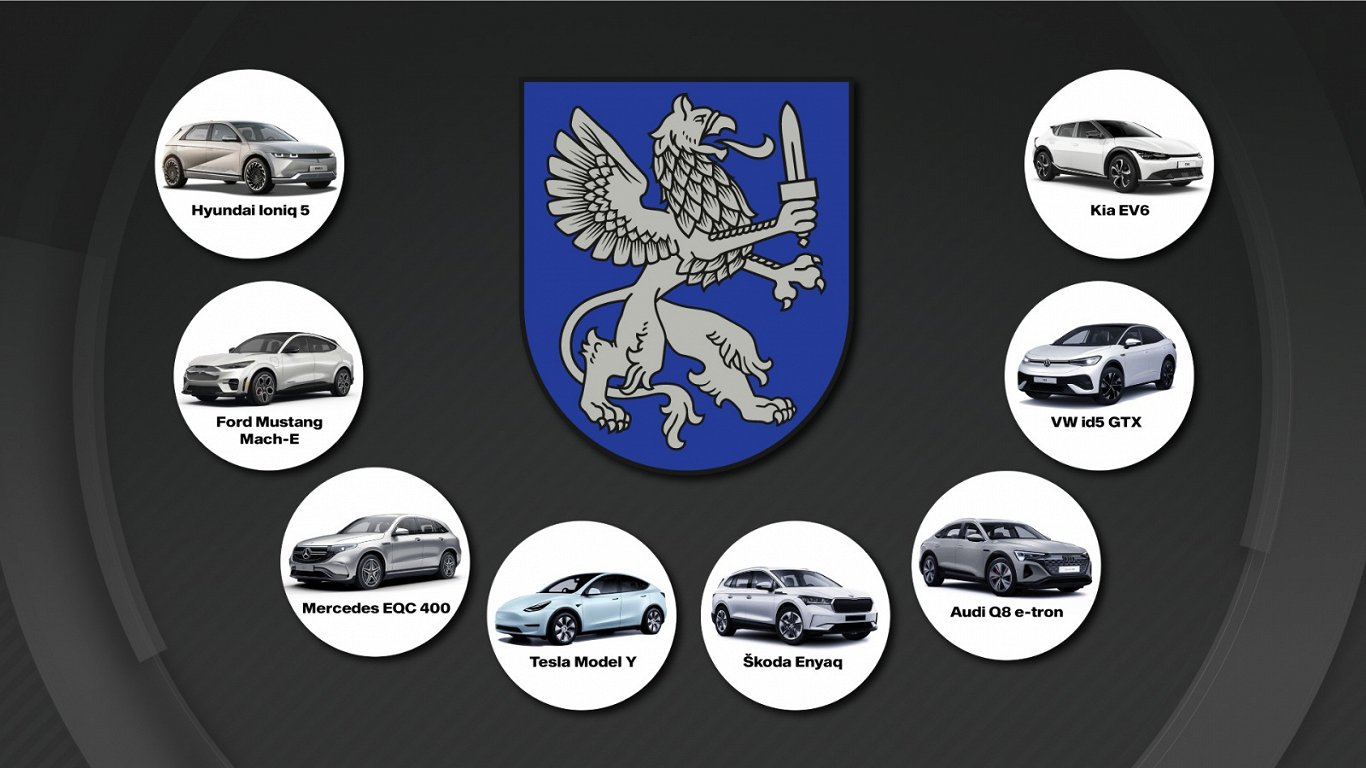The latest subject of discussion is a transport tender for the Latgale Planning Region (LPR). By most metrics, Latgale is Latvia's poorest and most deprived region with average incomes well below the national average and unemployment well above the national average. LPR is one of the bodies hoping to promote economic stimulus and development in the region. It was founded in August 2006 with the aim to ensure the planning and co-ordination of regional development, and co-operation between local government and other state administrative institutions. It is funded from the state budget.
LTV's team noticed a tender was live for a new vehicle for LPR. The technical specification of the tender announced on July 19 states that the electric car must have all-wheel drive and must be able to travel at least 500 kilometers on a single charge. The all-wheel drive requirement in the case of an electric car means a car with two electric motors, one for each axle, and in combination with the hefty 500 km requirement means that very few models curently available on the market can meet it.
Two days before a deadline for submission of car procurement tenders, which was set for August 10, the program sent a series of questions about this procurement to the Latgale Planning Region (LPR) administration.
The very next day, the database of the relevant electronic procurement system showed that the procurement had been terminated, which was later explained by an error in the technical specification.
Paying a premium
An expert in the auto industry, who wished to remain anonymous, told KNL that such requirements essentially correspond to "premium" class vehicles. In total, seven possible "candidates" can be identified. The cheapest dealer offers that meet these requirements are the Korean-made "Hyundai Ioniq 5" and "Kia EV6", and their prices are, respectively, around 53,000 euros and 61,000 euros, including VAT.
The requirements are also met by "Tesla Model Y Long Range", "Mercedes EQC 400", "Ford Mustang Mach-E", "Volkswagen ID.5 GTX", "Skoda Enyaq 80c" and "Audi e-tron Q8 S", which is towards the top end of the price range and costs almost 77,000 euros. "Tesla" cars do not have official dealers in Latvia, but in Germany, where there is a European production plant, the price of such a car starts from around 45,000 (without VAT).
However, none of these cars correspond to the 'small offroad' car class specified in the purchase conditions, according to the 2015 classification of the Latvian Auto Association. The set technical requirements correspond to the larger 'compact offroad' car class. After KNL asked how many car models correspond to the relevant class in the LPR assessment, the representative of the planning region replied that an error was made in the specification regarding the car class. The same information appears in the final report of the procurement in connection with the termination of the tender in which it is said that the relevant decision about the need to make amendments to the tender was made on August 7.
In the initial responses of LPR, it was also stated that the car's "provisionally planned contract price was over EUR 42,000.00 without VAT".
LPR is one of the five planning regions in Latvia. Its purpose is to ensure regional development planning, coordination, cooperation between municipalities and other state administrative institutions. There are 32 employees in the administration, and the heads of nine municipalities in the council. The chairman is Sergejs Maksimovs, head of Balvi district council, while his deputies are the chairman of Krāslava district council Gunārs Upenieks and until his recent dismissal, the mayor of Rēzekne, Aleksandrs Bartaševičs.
The financing of LPR from the state budget for this year is 925,458 euros. Of that amount, 182,000 is earmarked for running the LPR, and 100,000 for support functions.
So what is the LPR car fleet like and why do they need an all-wheel drive electric car with such a big power reserve that will eat up such a large chunk of their budget? The answer given by LPR at the beginning of September is that its current fleet is old and has seen a significant amount of use. LPR has at its disposal a 2013 VW Golf with 219,827 km on the clock, a 2015 VW Golf (135,048 km), a 2016 Opel Mokka (122,350 km) and a new 2022 Peugeot 208 that has covered just 4,791 km. Judging by the data of the electronic procurement system, this last model is an electric car – last year LPR bought a "Peugeot 208 Electric GT Pack" car for 35,300 euros without VAT.
The 'GT' trim level is not one of the entry-level models of the 208 range and comes with plenty of additional comfort features. While its maximum quoted range on a single charge is just over 400 km, things such as cold weather – of which there is plenty in Latgale – have a significant impact on the range of any electric car. According to the Electric Vehicle Database website, its realistic range is more like 285 km. In addition, it does not have all-wheel-drive.
Regarding the new car's required 500-kilometer range, the LPR answer to the program says: "Employees, fulfilling their duties go on long business trips, driving to distant cities, for example Tallinn, Helsinki, Ventspils, Vilnius. When making a trip, for example, Daugavpils to Tallinn, the road distance is at least 500 km".
On the one hand, the possibility of not charging the car along the way theoretically saves time. Several experts in the automotive field, commenting on the 500-kilometer requirement at the request of KNL, are of the same opinion that it significantly increases the price of the car and is a disproportionate extra, because in practice you will not drive such distances without stopping, while stopping for charging can be combined with a meal or work en route to the destination. For safety reasons alone, driving from Daugavpils to Tallinn without a break somewhere along the way would be inadvisable and, as demonstrated above, a quoted maximum range of 500 km might not necessarily be achievable in the freezing depths of a Baltic winter.
The representatives of the LPR explain the need for all-wheel drive as follows: "For employees to ensure the tasks and functions specified in the institution's regulatory acts (for example, the survey of bus stops by the employees of the Public Transport Department of the LPR, work visits by the employees of the Latgale Special Economic Zone Administration and the Latgale Entrepreneurship Center to manufacturing companies in rural areas), you have to constantly drive on the rural roads of the Latgale region during the winter, autumn and spring periods, when the road conditions are often very bad. Electric cars are heavier in terms of weight compared to internal combustion engine cars, and accordingly they can get stuck faster than a regular car on a muddy road."
That may be true, but it does beg the question of whether it might not be better in that case to choose something other than an electric car, which would have the benefit of being much cheaper as well as being less likely to get stuck in the mud.
Ministry sees no problems
The Ministry of Environmental Protection and Regional Development (VARAM), which is responsible for local authorities, in response to KNL's questions, claimed that it was not aware of such a procurement. The agreement between VARAM and LPR provides for "effective, efficient and legal use of the allocated state budget funding". Although, judging by the budget data, such an electric car purchase requires almost a fifth of the total annual state grants for maintaining the region and supporting the performance of functions, the ministry does not question the effectiveness and usefulness of the purchase.
"VARAM does not see any shortcomings in the announced procurement of the planning region. In VARAM's view, the demand for a power reserve is considered acceptable, taking into account the location of the planning region of Latgale and the distance to the capital," the Ministry told KNL. "The territory of the planning region covers both urban and rural areas, which are also connected by roads of a lower category." The answer also states that the LPR itself evaluates what means of transport it needs to purchase for the performance of its functions, taking into account the financial resources available to it and the depreciation of existing cars.
VARAM's answers were prepared when Māris Sprindžuks (United List) was the minister. Sprindžuks said that he does not know anything about the procurement in question, but does not see a problem in its technical requirements. The new minister in charge of VARAM is Inga Bērziņa (New Unity).
Going green or going expensive?
If we choose to drive a car, then an electric car is currently considered the best choice, says Jānis Brizga, doctor of environmental sciences, head of the Zaļā brīvība (Green Freedom) organization. However, he immediately points to future problems that should be tackled now, namely the recycling of car batteries. There is currently no economic incentive to do so. However, considering that the electric car is a zero-emission means of transport (at least when it is driving – obviously it in turn is powered by electricity that must be generated by some means and may involve emissions) it is a suitable vehicle for the environment and for meeting various international environmental requirements.
Brizga points out that an electric car is suitable for relatively short distances. Namely, not for those cases when you need to cover the 230 km from Riga to Daugavpils (which incidentally is all highway with no off-road sections), but, for example, for operating within city limits.
"It reduces air pollution in cities, which is critically important," says the environmental expert. In such cases, an electric car is an environmentally friendly solution for employees who travel a lot by car around the city every day for work purposes, for example taxi drivers or delivery drivers. It makes sense to replace polluting internal combustion engines with an electric car in such an environment.
Brizga admitted that often, under the pretext of going green, buying more exclusive and more expensive cars is certainly something that happens. He agreed that the demand for a 500-kilometer range on a single charge must be expeted to result in a significant increase in the car's list price.
Meanwhile, in the electronic procurement system, the procurement status of the electric car for the Latgale planning region is still listed as "Suspended".






























